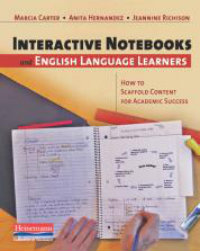How Interactive Notebooks Can Boost ELL Learning
Interactive Notebooks and English Language Learners: How to Scaffold Content for Academic Success
By Marcia Carter, Anita Hernandez and Jeannine Richison
(Heinemann, 2009 – Learn more)

Reading a book like Interactive Notebooks and English Language Learners – How to Scaffold Content for Academic Success, makes me wish I had my own classroom so that I could freely implement all of the strategies described here. However, due to my current position as a MS ESL teacher, I can only highly recommend these strategies to the classroom teachers I work with. And that is exactly what I have done.

As the authors note, the concept of interactive notebooks is not new. It originated with the Addison-Wesley History Alive! Social Studies program. However, many teachers have taken this concept and are using it in various content area classes.
From ELLs to ALLs
As an ESL teacher I was immediately drawn into this book because of this statement: “the Interactive Notebook can be used to scaffold content to move English language learners (ELLs) to the stage where they are academic language learners (ALLs),” (p. 3).
Bingo! Isn’t this the major focus of ESL teachers’ time with our students? We are expected to move our students from basic social English to academic English, which they are expected to sustain and extend in their content area classes; in my International IB School this has been the most difficult challenge facing our school team.
This dilemma is further exacerbated when we have new students with little to zero English language knowledge. How do we help them access the concepts in their content area classes? Short of having a sheltered ESL classroom, the next best thing may just be the use of interactive notebooks in content area classes.
Tailoring Interactive Notebooks to ELLs
This book is divided into eight chapters that lead the reader from learning about interactive notebooks to implementing them with students. In Chapter One, we are introduced to the advantages of interactive notebooks for all students. In addition to serving as an effective assessment tool, since they are individually designed but collectively created, they also serve as an archive of classroom learning. As a result, they contribute to the background knowledge of ELLs.
It is important to note that although interactive notebooks are ‘student-created,’ they are a ‘teacher-directed’ repository for note taking, commentary, and reflection that may be used as a study reference. Throughout each subsequent chapter the focus remains on how to engage ELLs and raise the level of their academic language regardless of their English language development.
(Figure 1.1, Chapter 1: Sample interactive notebook page)
Chapter Two walks readers through the steps for creating interactive notebooks. However, it is in Chapter Three that the specific needs of ELLs are emphasized. We are reminded of the immense cognitive demands that ELLs face in a regular English classroom with regards to listening and comprehending vast amounts of content area information.
We are urged to support our students as they gain communicative, academic and socio-cultural competence in their new language. Interactive notebooks, precisely because they scaffold learning, provide the necessary elements that support students to do this kind of work; the authors guide readers through specific ways to make the notebooks – the subject area content – accessible and useable to students.
Chapters Six, Seven and Eight provide excellent examples of lessons, including a mini novel study, scaffolded for middle and high schools students. If nothing else, the lessons can be used as described to provide an initial experience for using interactive notebooks.
A Role for Parents
Since I am an advocate for developing and nurturing authentic school-parent partnerships, I was very interested in how the authors involve parents with their children’s interactive notebooks. For example, they recommend that students take their interactive notebooks home to share with parents and provide structures for parents to comment on their child’s learning through the notebooks. They include a ‘guided interview form’ that parents can use for this purpose (p. 59).
Next school year, a new MS ESL teacher will be joining our team. In fact, most of the MS will consist of new faculty, including the principal. There are changes, as yet to be clearly defined, that will be happening in our school, particularly regarding the teaching and learning of ESL students. This will be the first year of a new strategic plan.
This is an exciting time; we have the opportunity to create new and more effective teaching/learning models, such as a collaborative teaching partnership between the classroom teacher and the ESL teacher. As we reconsider our blended push-in/pull-out model of teaching ESL students, Interactive Notebooks and English Language Learners – How to Scaffold Content for Academic Success, will be a great book to help us start this conversation.
Elisa Waingort has been teaching in bilingual settings for more than 25 years in public and international schools in North and South America. She is currently teaching ESL in middle school at Academia Cotopaxi, an American International School in Quito, Ecuador. Elisa blogs at A Teacher’s Ruminations and is a member of Cooperative Catalyst. She is also a member of the Elementary Section Steering Committee of the National Council of Teachers of English and has served on NCTE’s Executive Committee. She’s also uncovering Twitter’s power @elisaw5.



































